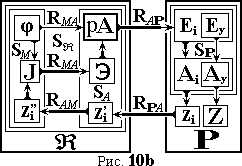.
MECHANISMS of ACTIVITY
3.5. PREACT and EMOTION
è
The psychological notion of PREACT pA pA functionally coincides with physiological notion of reflex. A person is born with a few ready (congenital) PREACTS (unconditioned reflexes, instincts) – the swallowing one, several protective (grasping, blinking, crying...), the first of which is formed (by the end of the first month of pregnancy) the PREACT of cardiac beats. The others are formed in postnatal practice by the trial and error method.
|
If a baby has caught at last his bright rattle suspended above him after a series of attempts, at which his hands only touched it (or even did not touch), so in the following series he will catch it more confidently, a number of unsuccessful attempts will be reduced. The successful complex Eó (fig. 10b) of muscular efforts (the last one in a series Ei) becomes just an element of the motor memory, i.e. is used at formation of PREACT pA for the next attempt (or the next series).
The other element of person's astralum body (or astrosoma), the emotion Э becomes the psyche criterion and regulator for choice this very (successful) complex of efforts Eó.
| |  |
Emotions are caused not only by images and thoughts, but also by separate sensations. A taste of sugar and a taste of salt, vinegar, cinchona will cause different emotions. But the main is that they will cause them. Emotion is possible to interpret as an astrosoma element, or as an astrosoma state, but in any case – it is an astralum object, is a result (an image) of evaluation of some other psyche object/element (of a sensation, an image or a thought) in the way of uncompromising contrast: good÷bad, pleasant÷unpleasant, etc. Emotion is formed also at evaluation of result zi of each next attempt Ai, on the basis of its (zi) comparison J (actually of its reflection zi'') with the intentional (desirable) aim Z containing (as Z'') in intention j ( see fig. 8).
The fact of achievement of a purpose Z causes positive emotion which can become a stimulus for changing an intention j: now it is necessary to try the rattle's teste (after testing it by color, sound and touch – to pull it into a mouth). On the fig. 10b the contour with two return reflections Rb (RÌÀ and RÀP – activity is performed by them) and two direct reflections Rb (RÌÀ è RÀP – control of results of this activity is carried out by them) is marked out.
Multiple performance of the cycle round this contour forms, improves, strengthens a PREACT pA (makes it more powerful, stable). Subjectively a person S perceives this as more and more precise, more eidetic, beforehand knowing of the forthcoming actions A at each next realization. Externally (for an observer, researcher) this fullvaluableness of pA is revealed as automatism of the action A, as its (A) interiorisation.
Passing remark.
Peter Ja. Galperin/ Ïåòð ßêîâëåâè÷ Ãàëüïåðèí (1902-89) showed [ 23 ], that comprehensive/physical action at multiple repeating condenses stage by stage and passes into internal, more and more deep, layers of psyche, so that at the last stage (of pure idea) the condensed action is already not always accessible for introspection. P.Ja. Galperin did not discover the essence/mechanism of the phenomenon (interiorisation) and only marked importance of the task decision.
è
